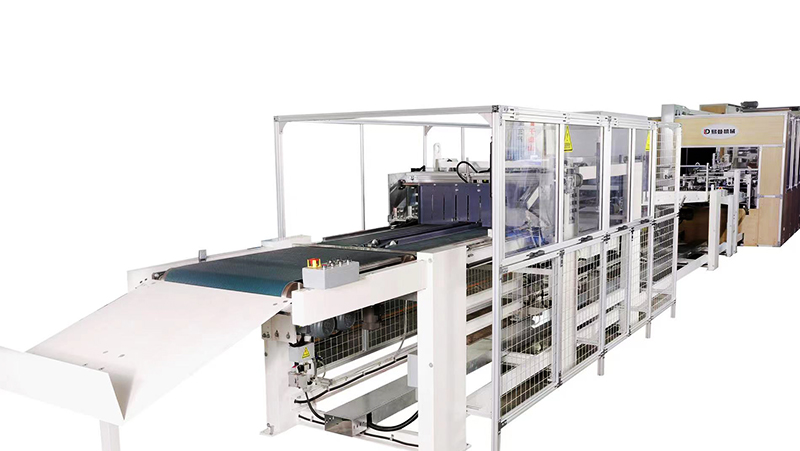Innovations in Paper Bag Machine Engineering: Efficiency, Sustainability, and Technological Advancements
Release time:2025-05-26 Classification:Knowledge
The evolution of paper bag machine engineering has revolutionized packaging industries worldwide, combining precision manufacturing with eco-conscious design. As global demand for sustainable packaging solutions grows, engineers and manufacturers are prioritizing advanced machinery capable of delivering high-speed production, material efficiency, and reduced environmental impact. This article explores the core principles, innovations, and future trends shaping modern paper bag machine engineering.

1. The Mechanics of Paper Bag Production
Paper bag machines are intricate systems designed to convert raw materials—primarily kraft paper or recycled fibers—into finished products through a multi-stage process. Key components include:
- Unwinding Systems: Precision-controlled rollers feed paper sheets or reels into the machine, ensuring consistent tension and alignment.
- Printing Units: Flexographic or digital printing modules apply branding or designs with minimal ink waste.
- Plastic-Free Sealing Mechanisms: Advanced adhesives or ultrasonic bonding techniques replace traditional plastic lamination for eco-friendly seams.
- Forming and Folding Stations: Automated systems crease, fold, and shape bags into predefined sizes, from flat-bottomed grocery bags to intricate retail pouches.
- Cutting and Stacking Modules: High-speed blades trim excess material, while robotic arms organize finished bags for packaging.
Modern machines integrate servo motors and programmable logic controllers (PLCs) to optimize speed (up to 300 bags per minute) while maintaining tolerances as tight as ±0.5 mm.
2. Sustainability-Driven Engineering
Environmental considerations are central to contemporary paper bag machine design. Engineers focus on:
- Material Optimization: Algorithms calculate minimal paper usage per bag, reducing waste by up to 20% compared to older models.
- Energy Efficiency: Regenerative braking systems in motors reclaim kinetic energy, cutting power consumption by 15–30%.
- Recyclability Compliance: Machines are calibrated to avoid chemical treatments or non-paper additives, ensuring end products meet compostability standards.
- Waste Reduction: Real-time monitoring systems detect defects early, diverting flawed sheets for reuse in lower-grade products.
Such innovations align with circular economy principles, enabling manufacturers to meet strict certifications like FSC (Forest Stewardship Council) or EU Ecolabel.
3. Automation and Smart Technologies
The integration of Industry 4.0 technologies has transformed paper bag manufacturing:
- IoT-Enabled Diagnostics: Sensors monitor machine health, predicting maintenance needs to prevent unplanned downtime.
- AI-Powered Quality Control: Vision systems inspect print clarity, seam integrity, and dimensional accuracy at production speeds, achieving defect rates below 0.1%.
- Adaptive Workflows: Machines automatically adjust settings based on paper thickness, humidity, or ink viscosity, ensuring consistent output across batches.
- Remote Operation: Cloud-based platforms allow technicians to troubleshoot or update software globally, reducing on-site service costs.
These advancements enhance productivity while enabling smaller manufacturers to compete in dynamic markets.
4. Challenges and Solutions in Machine Design
Engineering reliable paper bag machinery requires addressing unique technical hurdles:
- Material Variability: Recycled paper’s inconsistent fiber density demands adjustable tension controls to prevent tearing.
- High-Speed Jamming: Anti-static systems and laser-guided alignment mitigate misfeeds during rapid operation.
- Durability in Harsh Environments: Stainless steel components and IP-rated enclosures protect against dust and moisture in industrial settings.
- Customization Demands: Modular designs allow quick reconfiguration for specialty bags (e.g., handles, gussets, or custom shapes).
Rigorous testing protocols, including ISO 9001 compliance, ensure machines withstand 24/7 operation with minimal performance degradation.
5. Future Trends in Paper Bag Machine Engineering
Emerging technologies promise further disruption:
- Nanocellulose Materials: Machines may adapt to process ultra-thin, high-strength bio-based films.
- Hybrid Energy Systems: Solar or hydrogen-powered units could reduce reliance on grid electricity.
- 3D-Printed Components: On-demand manufacturing of machine parts using metal alloys or polymers may slash lead times.
- Blockchain Traceability: Embedded sensors could track raw material origins, providing supply chain transparency for eco-conscious buyers.
Paper bag machine engineering sits at the intersection of tradition and innovation, balancing decades-old mechanical principles with cutting-edge sustainability and automation. As consumer preferences and regulatory pressures drive demand for greener packaging, engineers will continue refining these systems to deliver unmatched efficiency, adaptability, and environmental stewardship. By embracing smart technologies and circular design philosophies, the industry is poised to redefine packaging standards for decades to come.






